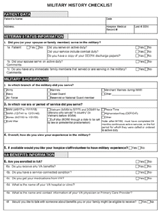Identify Veterans upon Admission
Veterans may have experiences from their military service that present unique needs at the end of life. Because the unique needs of Veterans may require specific interventions, the first step to addressing these issues is to identify them as Veterans. The Military History Checklist is available to identify who is a Veteran, evaluate the impact of the experience and determine if there are benefits to which the Veteran and surviving dependents may be entitled.
The Military History Checklist is a short and simple form that can easily be implemented within your organization. The Military History Checklist Fact Sheet explains the basics of the form and can be handed out to staff, the Military History Checklist Guide provides a quick overview of the Military History Checklist questions and their implications.
By implementing the Military History Checklist, you will be able to identify:
- Branch of Service
- Time of Service
- Combat
- Possible VA benefits
Ask about a Veteran’s Time in the Service
Since many Veterans’ stories were never heard, it is important to create a trusting environment and encourage their combat and/or other related experiences. By taking the time to ask about their time in the service, feelings of guilt, anger and other emotions can also be acknowledged.
The Military Service History Pocket Card is a pocket-sized resource from the Department of Veterans Affairs to help health care providers initiate conversations with military service members and Veterans. The information gained from the questions provided in the Military Service History Pocket Card will help to understand Veterans’ medical problems and complaints, and establish rapport and therapeutic partnerships. The information will also provide a basis for timely referral to specialized resources if needed.

More information about the Military Health History Pocket Card for Clinicians.




